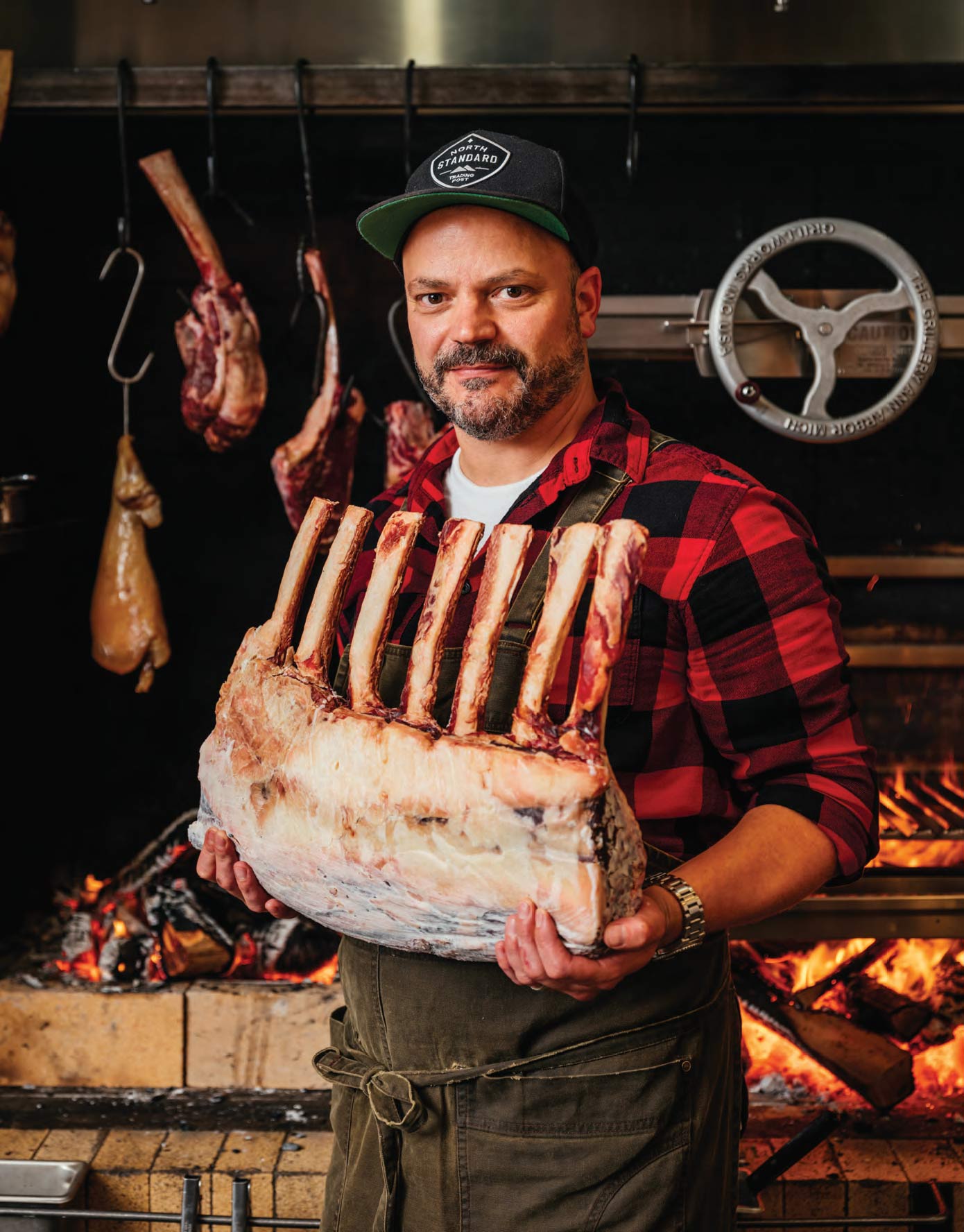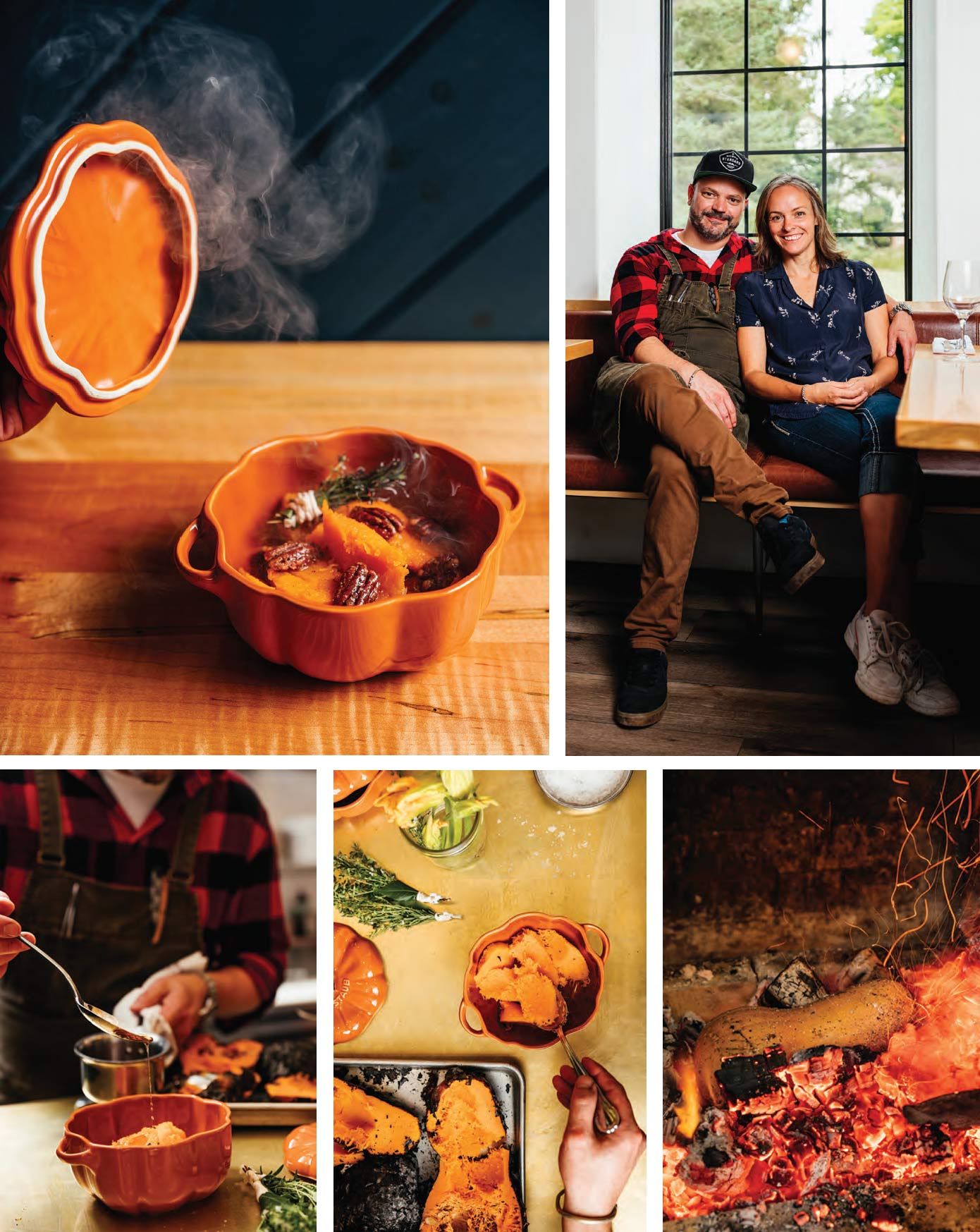
Chef Hidde Zomer


Left to right: Justin da Silva, Jessica Nettleton, Mallory Jones from Matron Fine Beer, Nancy Self from Tamarack Farm and Sebastian Chow and Nick Sorbara from Edwin County Farms
Chef Hidde Zomer is serious about the alchemy of fire and food at this Prince Edward County gem.
Good chefs understand the magic of playing with fire. At Bloomfield’s Flame + Smith restaurant, Chef Hidde Zomer combines woodfire cooking with open flames and embers to create a sizzling dining experience.
There’s an ethos and passion that infuses both the menu and the atmosphere at Flame + Smith.
When they created their restaurant, Hidde and his wife Sarah, who is the business’s coowner, worked with Toronto design firm Stacklab to convert the 120-year-old former forge/dairy/roadhouse into two spacious rooms oozing with rustic charm: exposed, rough-hewn rafters, sliding barn doors, and a Scandi-style wood-burning stove warming a couple of comfortable tub chairs.
It’s during fall and winter that the interior of the place is at its cosy best, with the stunning custom-built grill, hearth and a wood-fired oven where Hidde’s farm-to-fire cooking takes centre stage. A chef with a passion for firewood, Hidde has stacked and displayed small logs like wine bottles near the sunken open kitchen, each shelf labelled with the wood’s species and region of origin.
The bar, handsomely clad in black antique tin ceiling tile and punctuated with burnt orange bar stools, sits idle at the moment, patiently awaiting the time when life again allows bars to function as they’re intended: to bring people together. The dining tables have been spaced the mandated distance apart. The harvest tables – once a centre of conviviality – are in storage for the moment, but not forever.
The rooms are the ideal setting for the food that’s prepared and served in them. Hidde and Sarah know that the best food is often the simplest. It’s a grass-fed steak, dry-aged; it’s perfectly crispy skin and properly charred meat with the subtle essence of hickory, maple and apple wood; it’s a squash picked at seven in the morning and tossed on the coals for dinner, a perfect example of “farm-to-fire” cooking. Cooking in embers and ashes is a technique Hidde often uses at Flame + Smith. See the recipes below.
Everything starts with proper care and attention to the ingredients Hidde and Sarah gather. They know the value of a well-raised animal or of produce that has been grown only metres away, with kindness and integrity. And they work closely with some of the best purveyors in both Prince Edward and Northumberland Counties.
The wet blanket of COVID-19 has not been nearly enough to douse the flame of creativity of the restaurant’s team. But it hasn’t been easy. “In March,” says Sarah, “we suffered a huge loss. There was a moment when we wondered how long we could last.” In self-preservation mode, the couple got to work right away adapting to the situation.
“Since COVID, we’ve basically opened three different restaurants,” she says. “We’re down to 42 seats from 135, and our patio is operating at about 30% of its capacity.” For a restaurant that already operates on thin margins, this hits hard.
“But,” Sarah adds, “we’re rolling with it. We’ve increased the surface area of our outdoor space; and we’ve become a take-out place too.”
Hidde had to rethink the menu, making it more portable and more family-friendly. Sarah retooled the kitchen, putting plates and silverware in storage and replacing them with takeout containers; she also revamped the restaurant’s website, adding an ordering platform. Sensing that this was the new normal – at least for the foreseeable future – the couple installed a washing station on the patio, so patrons could clean up without setting foot inside.
It was stressful, but by April, the duo were finding a new groove with take-out and curbside pick-up being ordered by loyal customers daily. They were even able to start hiring back some staff. “We’re proceeding with caution,” says Sarah, “just living in the moment.”
And in that moment, there is the restaurant’s kitchen garden to harvest; the couple’s two young boys – Evo and Hugo – to care for; and to come, the as yet unknowable-but-inevitable challenges of running a restaurant in the County in winter during a pandemic.
Come winter, it will be the fierce PEC sense of community that will help everyone – farmers, bakers, shop owners, and the Zomers – weather this storm. As Sarah said, “When you have a lot on the line, you hustle, and I keep reminding myself that a high tide raises all ships.”
Ember-Roasted Butternut Squash with Maple, Whisky, Candied Chili Pecans and Torched Herbs
“This side dish will complement any roast dinner – fall or winter – and is perfect on the holiday table. We always get excited for the local fall harvest when squashes are abundant. We have tested this dish with many different varieties of squash – Peruvian blue Hubbard and butternut squash both do well with this low and slow method. Done correctly, the inside of the squash will become intensely sweet and smoky with a texture similar to a roasted chestnut. If you can’t build a fire, it can be made in the oven. The recipe is made up of several components, so start with the candied chili pecans.” HIDDE ZOMER
CANDIED CHILI PECANS
Ingredients
1 cup pecan halves
¼ cup maple syrup
1 ½ tbsp. butter
¼ tsp. chili powder
- Preheat oven to 350°F and line a cookie sheet with parchment paper; set aside.
- In a small saucepan over medium heat, combine the maple syrup, butter and chili powder, and bring to a boil.
- Stir in the pecans and mix until well coated. Spread the pecans and the remaining sauce evenly over the prepared cookie sheet; bake for 5 to 8 minutes. They should look caramelized and a little sticky. Allow to cool and then transfer to a small, lidded container.
BURNING HERB BUNDLE
We use a combination of fresh thyme, savoury, rosemary and a large bay leaf for this aromatic garnish.
- Place the bay leaf on the counter and make a little bouquet by placing the other herbs inside the bay leaf. Take a small length of kitchen twine and tie it securely around the bottoms of the herb stems and bay leaf; set aside until ready to use.
EMBER-ROASTED SQUASHES
Ingredients
2 butternut or Peruvian blue Hubbard squashes
Sea salt to taste
- Build a fire in an outdoor pit or in a kettle BBQ.
- Try to find some good hardwood; we love the mulberry wood from Tamarack Farms, the way it burns slowly into large embers and smoulders, throwing off a delicious, fruity smoke. Cherry wood acts similarly, but if you don’t have access to either of these, any hardwood will do.
- While waiting for the wood to burn to embers, prepare the Maple Syrup Whisky Sauce.
MAPLE SYRUP WHISKY SAUCE
Ingredients
1 cup maple syrup
1 oz. bourbon or Canadian whisky, preferably not too smoky – the wood smoke will provide all the smoke you need.
- Into a small saucepan add the syrup and whisky. Set over medium-low heat, whisk and bring up to a simmer – do not boil – remove from heat and set aside.
FIRE ROASTING
- When the fire has turned to embers and most of the flames have disappeared, place the squashes directly into the middle of the embers. Using a shovel, cover the squashes gently with some of the surrounding embers and ashes.
- Depending on size it will take approximately 40 minutes to 1 hour for the squashes to cook.
- Halfway during the process, rotate the squashes using either large tongs or small fireplace shovel, and cover with more hot ember and ashes.
- Use a thermometer to probe the thickest part of the squash; when the temperature reaches 180°F the squash is done.
Tip: If you don’t have a thermometer, use a small paring knife to pierce the flesh. The knife should slide in easily, but with a little resistance. - Pull the squashes out and gently brush off embers and dust. Allow the squashes to rest for 15 minutes.
- Place the ember-roasted squashes on a cutting board and cut each squash in half lengthwise using a sharp, serrated knife. Carefully scoop out the seeds.
- Using a large soup spoon, scoop out the cooked flesh, without taking any of the burned outer skin, and arrange the scoops in a ceramic baking dish with a lid.
- Drizzle the maple whisky sauce over the squash. Place the candied pecans on top and add a sprinkle of good sea salt.
- Just before serving, introduce a flame to the top of the herb bundle – a lighter, small kitchen torch or gas flame will work – then place the smouldering little bundle inside of the dish and close the lid immediately. Bring straight to the table and remove the lid. The dish will beautifully perfume your dining room with its woody aromas.
Oven-Roasted Method
- Preheat oven to 350°F.
- Cut squashes in half lengthwise and scoop out the seeds.
- Place squashes on baking sheet or in a baking dish.
- Into the hollows of each half, pour a little Maple Syrup Whisky Sauce and a tablespoon of butter.
- Sprinkle with a pinch of sea salt and bake for 30 to 40 minutes, or until the outside has taken on some colour and the squash is tender.
- Use a spoon to baste the squash during the baking process for deeper caramelization. * Serve garnished as in the Ember-Roasted method.
Bon appetit!
Justin da Silva, Jessica Nettleton, Mallory Jones
Matron Fine Beer
Friends for a decade and hospitality industry pros, Justin da Silva, Jessica Nettleton, and Mallory Jones founded their Bloomfield brewery in 2018. With Jessica and Mallory handling the day-to-day operations and sales, Justin is able to focus on creating innovative brews using local ingredients.
“We use at least 50% or more Ontario hops, but they’re hard to find” says Mallory. “Beer is very tied to the latest trends, but we’re interested in making a truly local product that is also lower alcohol. Our highest is 6%, most are about 4%. Being drunk is not the goal; it’s about enjoying really good beer.”
Grains are locally grown: the barley is from Barn Owl Malt on the Bay of Quinte and the hops from Pleasant Valley in Hillier; the yeast comes from Escarpment Laboratories in Guelph. It’s a perfect pairing with Flame + Smith. “We are just loving what they do,” says Hidde. “All their beers are made with Ontario ingredients and simply beautiful; we sell so much of it at our restaurant. And we all drink it after a long day in the kitchen.”
Nancy Self
Tamarack Farm
Since 2012, Nancy and Richard Self have been rehabilitating 380 acres of Northumberland County farmland that sat fallow for 60 years. Growing heirloom herbs, flowers and vegetables, Nancy explains, “Our produce is vine-ripened, which means the produce is picked, packed and delivered on the same day.”
This has great appeal to Chef Zomer. “Nancy and Richard raise organic produce, pasture-raised lamb, heritage pigs, and gold medal-winning maple syrup. They are great supporters of our restaurant – they often dine with us – and have been of great help with many of our projects.” The love is mutual. “We work with a selective group of chefs – thought leaders – who understand what we’re doing,” says Nancy. “Hidde is exactly the kind of chef we want to work with.”
The Self’s livestock is certified by A Greener World, an organization dedicated to protecting the wellbeing of land, livestock, farmers and consumers. Their maple syrup is also certified organic, and as Nancy explains, “We focus on the health and wellbeing of the entire forest eco-system.”
@tamarack_farms
Sebastian Chow and Nick Sorbara
Edwin County Farms
Nick Sorbara grew up on a hobby farm in Maple, just north of Toronto. “I always knew I would be a farmer one day,” he says, and four years ago he made the leap, leaving the day-to-day operations of his entertainment production company, Red Lab, for full-time farming.
Today, Nick works with Sebastian Chow raising heirloom vegetables, grains, flowers, and about 50 head of beef – Black Angus and Belted Galloways – on the Sorbara family farm outside of Picton.
“My parents bought the farm 50 years ago, and they’ve been rehabilitating the land ever since,” says Nick.
On the 700-acre farm, all livestock is pastured; there are 50 acres of spelt and 20 acres of Red Fife wheat, and the woodlot yields about 750 litres of maple syrup. “We grow the most interesting, most flavourful varieties of vegetables we can find,” explains Nick. “And with only two acres producing vegetables, we farm at a small enough scale that we can really monitor and assure they are the very best quality.”
@edwincountyfarms
Story by:
Signe Langford
Photography by:
Johnny C.Y. Lam




